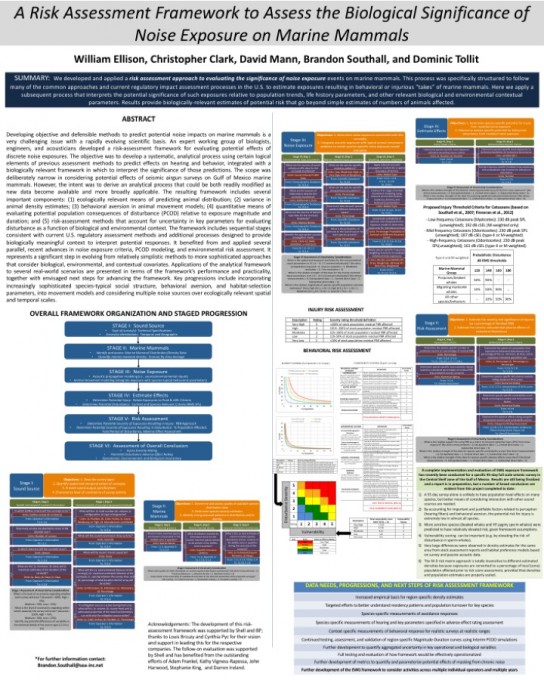An expert working group consisting of B. Southall, W. Ellison, C. Clark, and D. Tollit presented a poster summarizing a recently developed risk assessment framework to evaluate the potential significance of noise exposure on marine mammals. The poster was presented at the 21st Conference on the Biology of Marine Mammals in San Francisco. The abstract of the poster is given below and a full version of the poster is available here (or is available from Brandon.Southall@sea-inc.net):

Developing objective and defensible methods to predict potential noise impacts on marine mammals is a very challenging issue with a rapidly evolving scientific basis. An expert working group of biologists, engineers, and acousticians developed a risk-assessment framework for evaluating potential effects of discrete noise exposures. The objective was to develop a systematic, analytical process using certain logical elements of previous assessment methods to predict effects on hearing and behavior, integrated with a biologically relevant framework in which to interpret the significance of those predictions. The scope was deliberately narrow in considering potential effects of seismic airgun surveys on Gulf of Mexico marine mammals. However, the intent was to derive an analytical process that could be both readily modified as new data become available and more broadly applicable. The resulting framework includes several important components: (1) ecologically relevant means of predicting animal distribution; (2) variance in animal density estimates; (3) behavioral aversion in animal movement models; (4) quantitative means of evaluating potential population consequences of disturbance (PCOD) relative to exposure magnitude and duration; and (5) risk-assessment methods that account for uncertainty in key parameters for evaluating disturbance as a function of biological and environmental context. The framework includes sequential stages consistent with current U.S. regulatory assessment methods and additional processes designed to provide biologically meaningful context to interpret potential responses. It benefited from and applied several parallel, recent advances in noise exposure criteria, PCOD modeling, and environmental risk assessment. It represents a significant step in evolving from relatively simplistic methods to more sophisticated approaches that consider biological, environmental, and contextual covariates. Applications of the analytical framework to several real-world scenarios are presented in terms of the framework’s performance and practicality, together with envisaged next steps for advancing the framework. Key progressions include incorporating increasingly sophisticated species-typical social structure, behavioral aversion, and habitat-selection parameters, into movement models and considering multiple noise sources over ecologically relevant spatial and temporal scales.
